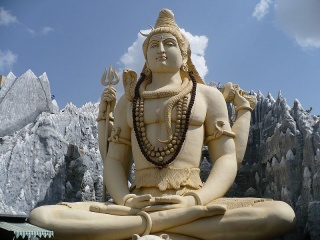Śiva: Difference between revisions
Jump to navigation
Jump to search
Pablo Sender (talk | contribs) No edit summary |
Pablo Sender (talk | contribs) No edit summary |
||
| Line 3: | Line 3: | ||
'''Śiva''' (devanāgarī: शिव) is a [[Sanskrit]] word meaning "auspicious one" is a major [[Hinduism|Hindu]] deity, part of the [[Trimūrti]]. He is the destroyer of evil or transformer. Shiva is depicted as a yogi, living a life of a sage at Mount Kailash. In images, he is represented as immersed in deep meditation or dancing upon the demon of ignorance. He is usually worshipped in the abstract form of [[Liṅgam|Shiva linga]]. | '''Śiva''' (devanāgarī: शिव) is a [[Sanskrit]] word meaning "auspicious one" is a major [[Hinduism|Hindu]] deity, part of the [[Trimūrti]]. He is the destroyer of evil or transformer. Shiva is depicted as a yogi, living a life of a sage at Mount Kailash. In images, he is represented as immersed in deep meditation or dancing upon the demon of ignorance. He is usually worshipped in the abstract form of [[Liṅgam|Shiva linga]]. | ||
[[Category:Sanskrit terms| | [[Category:Sanskrit terms|Shiva]] | ||
[[Category:Hindu mythology| | [[Category:Hindu mythology|Shiva]] | ||
[[Category:Hindu concepts| | [[Category:Hindu concepts|Shiva]] | ||
Revision as of 21:38, 21 April 2016
Śiva (devanāgarī: शिव) is a Sanskrit word meaning "auspicious one" is a major Hindu deity, part of the Trimūrti. He is the destroyer of evil or transformer. Shiva is depicted as a yogi, living a life of a sage at Mount Kailash. In images, he is represented as immersed in deep meditation or dancing upon the demon of ignorance. He is usually worshipped in the abstract form of Shiva linga.
